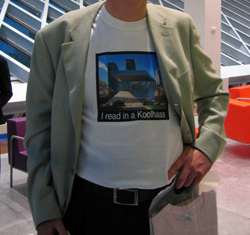This representation is the paper fold up model distributed to patrons of the Seattle Central Library, commemorating its opening. From a single surface, by cutting and folding, patrons could easily create the complex sinuous volume of this building. In fact, this model allowed the general public to roughly experience architect’s usual abstraction of 3-D space from a 2-D drawing. Offering a low entry barrier to architectural models, this representation can be compared to the several blogging services (such as wordpress) available on the internet which allow people without any programming skills to take an active role in the digital revolution. For example, this electronic project was only possible with the intuitive, easy and complete tools available in wordpress, which allowed to catalogue and structure in a simple manner our ideas regarding architecture in different media. Having created a database of different representations, only the electronic networked environment of this blogging service permitted the different connections between mediums to be revealed by using the established tag cloud. In fact, this simple digital tool allowed an architect and a film student to roughly experience a programmer’s usual abstraction of code into a functioning program.
Posts Tagged 'SPL'
physical model: fold up
Published March 11, 2008 Uncategorized Leave a CommentTags: 3-D, distribution, exterior, general audience, physical model, print, SPL
t-shirt
Published March 11, 2008 Uncategorized Leave a CommentTags: distribution, exterior, general, perspective, photograph, print, SPL, t-shirt
Here the Seattle Central Library is represented on the t-shirts available for purchase by patrons at the library’s gift shop which reads “I read in a Koolhaas”. This representation is worn by people, as a memento of their trip to the library. Like the prominent t-shirt with designer-name logo, now patrons can also exhibit their taste in buildings on their body. Through this deliberate product of the marketing/branding exercise, the image of the building is suddenly transformed into an article of consumption and circulated around the globe, as if the architecture had suddenly lost its mass and volume, and could now be consumed in such an original medium as clothing. Rather than architecture hosting the body, it is the body that hosts architecture, creating an extraordinary inversion of the traditional roles. In some way, this can be considered as an peculiar embodiment of architecture.
audio tour
Published March 9, 2008 Uncategorized Leave a CommentTags: audio, book spiral, children's corner, distribution, general audience, human figure, interior, mixing chamber, reading room, SPL, tour, web
An 18 minute audio tour of Seattle’s Central Library warmly guided by Diana from the SPL represents the library in this instance. This audio tour was intended to be downloaded by patrons to their mp3 player and used while visiting the library. Despite the listener being guided by the sound, where the narrator frequently gives indications and directions to follow the predefined route, this representation is complemented by the library vertical map available at the entrances of the building on a small scale, and by the actual spaces of the library on a larger scale. Without these other elements, the audio recording loses its meaning. Therefore, we observe in it a resistance to the creation of a single bubble of privatized space inherent to the delivery system of this audio file in personal mobile sound system. This audio track attempts to engage the listener with other people by featuring several “encounters” with librarians on different places, who explain the resources available and the underlying concepts of the spaces. It also aims at engaging the listener with the physical spaces by encouraging the listeners to pause the sound recording and explore the spaces on their own, at their own pace, which is demonstrated by the discrepancy between the actual length of the track -18 minutes- and the expected length of the tour -between 30 and 40 minutes.
video tour
Published March 6, 2008 Uncategorized 1 CommentTags: distribution, exterior, general audience, human figure, interior, SPL, tour, video, web
This virtual/video tour is lead by the Seattle city librarian and main supporter of the architectural project, Deborah L. Jacobs. Throughout the design and construction process Miss Jacobs was instrumental and a strong supporter of this innovative design. Intriguingly this representation is called a tour, implying an exploration or a visit around the building, where relations between spaces can be understood, but despite showing several images of both the exterior and the interior of the library, no coherent space-time continuity is illustrated, but rather different spaces are shown without almost any relational content, except for the information on which floor they are. Balance the lack of physical space continuity in this tour, there is an interesting interrelation between different mediums, such as photographs, diagrams, facts described and even a direct quote of the review by the New York Times architectural critic, Herbert Muschamp (also in this blog). Also significant in the context of our seminar, and explained in this tour, is the combination of print media, digital media and technology in this library, where books are tagged with RFID tags, and most processes are automated. Notoriously some detractors of the library criticize the abundance of computers in the children’s area. For these critics, children already have too many digital distractions in their life, and in a library should be focusing on encouraging children to read and use print material. This discussion is associated with the issue of different modes of perception, already debated in our seminar, where digital technology prompts a new mode of perception and understanding of the world, or a different “wiring” of the brain, particularly for children immersed in this media from a very tender age. Also in this children’s area the transition between print and digital media is not seamless.

